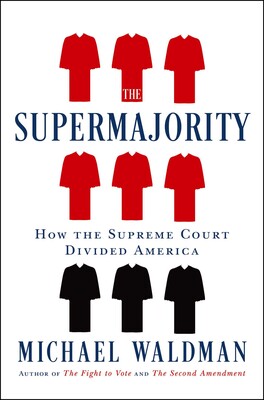The Supermajority: How the Supreme Court Divided America
- By Michael Waldman
- Simon & Schuster
- 400 pp.
- Reviewed by William Rice
- June 15, 2023
Chronicling a right-wing cabal’s fracturing of norms in the U.S.

Depending on the issue and your perspective, activist Supreme Court justices are either brave defenders of universal truths or autocratic destroyers of ordered liberty. For most of this century — and with particular intensity in the past few years — liberals have held the latter view, as the Court has struck down progressive acts of Congress and overturned longstanding social norms.
Though Michael Waldman, in his new book, The Supermajority: How the Supreme Court Divided America, blames leftists in part for the creation of the modern conservative Court and faults some of their reactions to it, he shares their alarm. He bluntly states that with three crucial decisions last year, the “Supreme Court of the United States showed itself to be one of [the current] threats to American democracy.”
Those decisions were, most prominently, to end the national right to abortion, accompanied by an expansion of gun rights and the restriction of the federal government’s ability to regulate emissions causing climate change. Issued within a single week in June 2022, this trio of rulings, Waldman effectively argues, deformed the relationship of government to society, one that had stood for a half-century or more. It was the supermajority of his book’s title — the six conservative justices appointed by Republican presidents — that decided those cases, over the often outraged dissent of the three more liberal members of the court, chosen by Democrats.
And the supermajority’s not finished remaking America. Depending on when you read this, it may have already ruled in favor of a theory of state-legislative power to unilaterally set election laws that Waldman quotes a former conservative federal judge as calling “the Republican blueprint to steal the 2024 election.”
In response, Waldman takes steady, deadly aim at “originalism,” the conservative judicial philosophy now animating the Court. (It’s a fitting metaphor since he believes it’s in the gun-rights ruling that the concept led the justices most astray.) Originalism holds that decisions should be wholly based on the supposedly plain meaning of the words in the U.S. Constitution.
Waldman argues with patient passion that those words, however revered, are not divine. They were composed by fallible, changeable human beings in sharp conflict with each other who were forging compromises that often relied on intentional ambiguity. What’s more, Waldman reasonably posits, intervening events and the real-world implications of Court decisions deserve equal consideration.
For a member of the liberal establishment — he’s head of the Brennan Center for Justice at NYU School of Law — Waldman casts a surprisingly critical eye on what he views as liberal excess both in the actions that helped create the right-wing judicial reaction and in the Left’s proposed solutions to the problem of an out-of-touch Court.
He accuses the mid-20th-century Warren Court — decider of rights-expanding cases ranging from school desegregation to criminal-defendant protections to contraception, and a cherished icon to liberal baby boomers — of eventually becoming “unmoored” from the law and public opinion, inviting the conservative ascendancy that followed. He thinks Roe v. Wade, the 1973 case that created a nationwide right to abortion, was poorly reasoned and needlessly energized the opposition. More broadly, he blames the Left of this period for its focus on individual rights above other social goods — “As rights advanced, notions of equality receded” — and for relying so heavily on the justices to advance its policies that its political muscles atrophied.
The author served on the commission President Joe Biden appointed to study possible reforms to the Supreme Court. Waldman opposes the progressive demand to expand the Court to fit in more liberals, thinking it invites retaliation and eventually an unwieldy number of jurists. He prefers instead 18-year term limits for the justices, who now serve as long as they want, noting such a plan’s popularity even among Republicans.
Waldman begins the book with a breezy, engaging history of the Court that brings the nonexpert up to speed. Because of its informality, this capsule tutorial occasionally strays into error but more often into a trove of fascinating facts. Did you know, for instance, that five of the nine current justices were chosen by presidents who won office while losing the popular vote (two by George W. Bush, three by Donald Trump)? Or that just before joining the Supreme Court in the early 19th century, John Marshall sparked the lawsuit that allowed him, as chief justice, to formulate the concept of “judicial review” — the idea that the Court decides what the Constitution allows?
Waldman is a generally clear and persuasive writer. But the book often reads more like an eloquent oral argument than a closely reasoned brief. Points arise not so much in logical order as in choppy, powerful waves — like they would in a lively conversation with a learned acquaintance.
For those of us conservative in our thinking if not our politics, originalism has definite appeal. How satisfyingly simple to consult texts written centuries ago, certain they offered fixed meanings then and the same ones now! But Waldman makes clear in The Supermajority that those texts are the place to start the search when deciding what the law demands, not the place to end it.
William Rice is a writer for political and policy-advocacy organizations.

